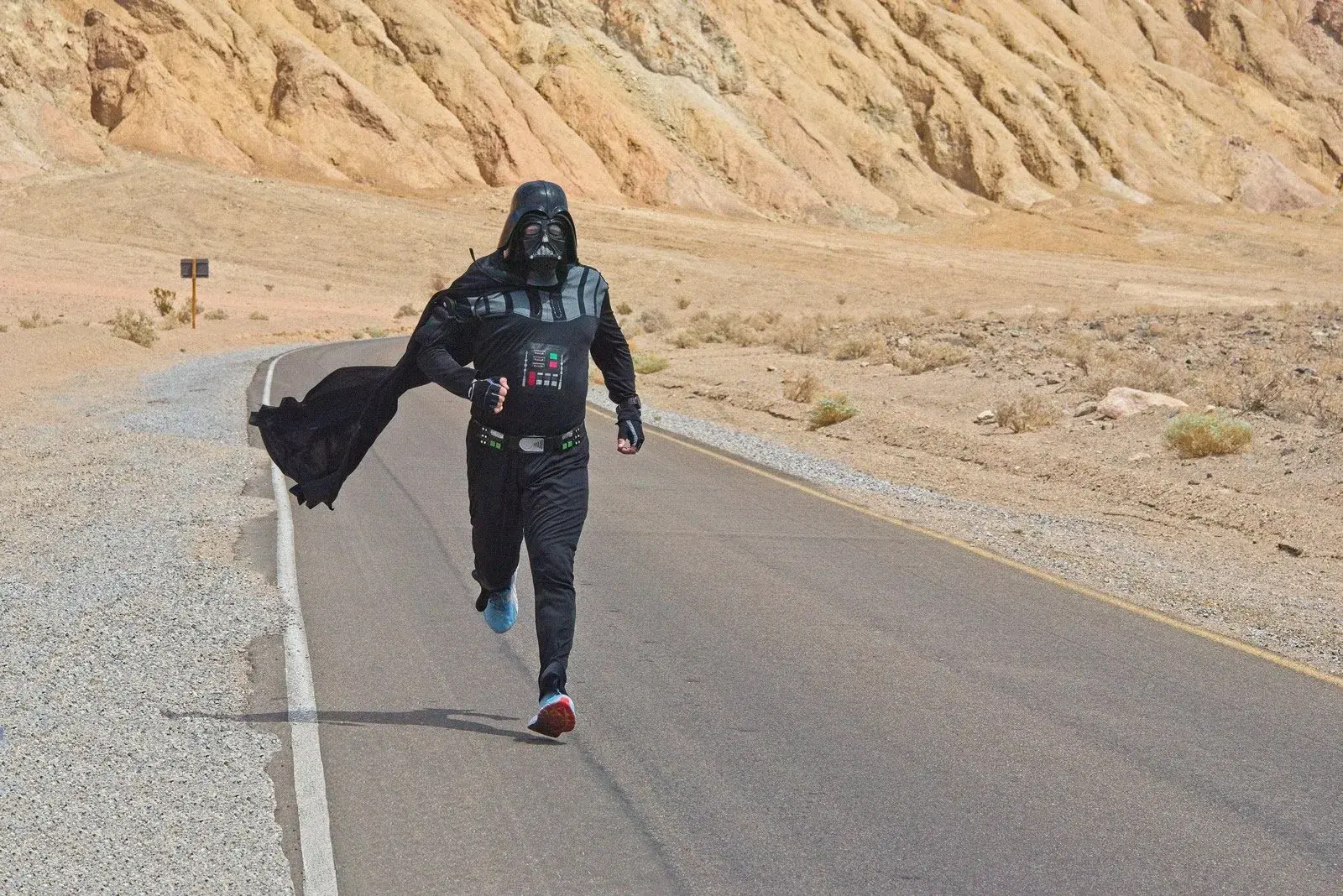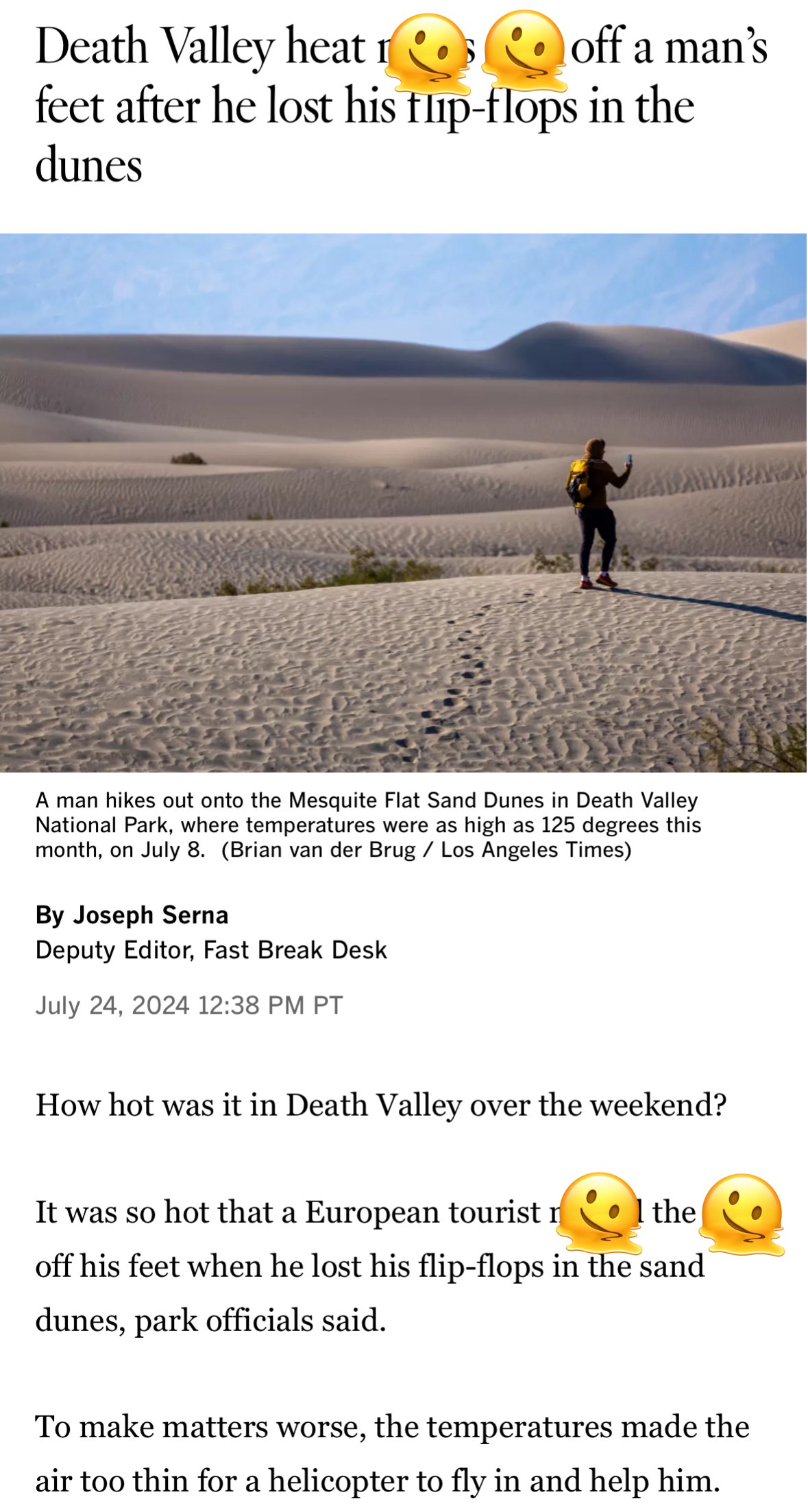Phoenix, Arizona, saw its 100th straight day of 100F (37.7C) heat this week.
The hottest large city in the United States broke its previous record of 76 consecutive 100F days set in 1993. The relentless streak, which started on 27 May and hit its 100th day on Tuesday, is forecast to persist into next week. An excessive heat warning is in effect through Friday, with temperatures expected to reach 110F (43C) tomorrow.
This summer was the hottest one in Phoenix since 1896, when records first began. Latest county data shows that at least 177 people died from heat-related causes so far this year, with 436 under investigation. Last year, Maricopa county saw 645 confirmed heat-related fatalities, enduring 55 days in a row with above 110F temperatures.
…
It’s brual. If you don’t have AC in your house/mode of transportation, you can literally die of heat stroke in a few hours.
A fire fighter trainee literally died in Tucson recently from heat stroke. It’s bad y’all. Stay away if you can.
Winter is decent though since it’s like 50 - 70 lol
Obligatory, but it’s a dry heat!
Whenever someone says that, my reply is “So is a fire. Go jump in one and let me know how it feels.” 🤣
Feels like Arizona!
LMAO OK. You got me with that one.
Slightly less racist tho
… huh?
Arizona is pretty racist. Is that not a known fact? I thought it was established.
it is well established; but there are plenty who willfully ignore that fact and you just ran into one of them.
Arizona is a state. While some of its residents have been known to struggle with skin color, and other simple concepts, the state itself is simply a geographic location.
I usually go with “so is your oven” but the sentiment atays the same
That’s a good version of it too.
20% at 111°F is a degree or so close to imminent heat stroke (followed by death).
So yes hydrometry counts (90% at 90°F is bad too) but it won’t always save you.
I’m a proponents of using a scale including hyrgrometry and not just only using temperature, especially when hot it’s such a bullshit measure (temp only).
Yeah in Florida heat stroke/exhaustion is more likely because your sweating is less effective (less capacity to evaporate off the skin.
In Arizona dehydration complications (and then heat exhaustion/stroke) are more common because your sweat is so effective and evaporates so quickly that you almost don’t even realize. You can lose liters of water in a matter of a few hours. Then suddenly, the sweat stops and you die.
(another thing that gets missed is direct infrared intensity when in direct sunlight, which Arizona takes the cake).
https://en.m.wikipedia.org/wiki/Wet-bulb_temperature
WBT 35°C or a WBGT of around 31°C represents the threshold where conditions become life-threatening.
100°F = ~37.8°C

Phoenix is a testament to man’s hubris.
hubris
https://en.wikipedia.org/wiki/Human_thermoregulation
In general, humans appear physiologically well adapted to hot dry conditions.
https://en.wikipedia.org/wiki/Perspiration
Although sweating is found in a wide variety of mammals,[6][7] relatively few (apart from humans, horses, some primates and some bovidae) produce sweat in order to cool down.
https://en.wikipedia.org/wiki/Persistence_hunting
Persistence hunting, also known as endurance hunting or long-distance hunting, is a variant of pursuit predation in which a predator will bring down a prey item via indirect means, such as exhaustion, heat illness or injury.[1][2] Hunters of this type will typically display adaptions for distance running, such as longer legs,[3] temperature regulation,[4] and specialized cardiovascular systems.[5]
Humans are some of the best long distance runners in the animal kingdom;[6] some hunter gatherer tribes practice this form of hunting into the modern era.
The Darth Valley Challenge
A one-mile sprint…
At the hottest time of the day…
On the hottest day of the year…
In the hottest place on Earth…
Dressed as Darth Vader.

That’s being done by humans for amusement. It’d kill most animals. Not saying that it’s comfortable, but we can deal pretty well with an awful lot of heat if we have to.
If you want to talk the talk, you gotta walk the walk. But if you can do the walk, hey…might as well strut it.
TIL about the Darth Valley Challenge. Thanks for that!
If you’re interested…that’s a sprint. Also in Death Valley, there’s the Badwater Ultramarathon:
The Badwater Ultramarathon is a 135-mile (217 km) ultramarathon race starting at −282 feet (−86 m)[1] below sea level in the Badwater Basin, in California’s Death Valley, and ending at an elevation of 8,360 feet (2,550 m) at Whitney Portal, the trailhead to Mount Whitney. It takes place annually in mid-July when the weather conditions are most extreme and temperatures can reach 130 °F (54 °C).
You sure need the proper footwear.

^ censored for a reason 🤢 link:
https://www.latimes.com/california/story/2024-07-24/death-valley-shoes-lost-skin-burns
I’ll never understand how settlers moving out west to the beauty and resources of the coast, got to a blank desert and decided to ”This is the spot!”
No lumber, fucking hot, and natural water is scarce. WTF
I know, let’s grow some alfalfa!
It was primarily settled as a farming community at the confluence of two rivers to support nearby gold mines. Prior to that native Americans had a fair amount of canal works to provide irrigation to agriculture in the region. At the time it would have been seen as good fertile land, free from rocks and boulders that was beyond the frost line prime for agriculture if they brought fresh water from the nearby rivers.
That fair amount of irrigation was created by the Hohokam, who also abandoned it like sane people.
Might also be worth noting that Arizona had a population of around 6k American settlers in 1860. About 160 years later, we’re trying to cram in over 7M at a growth rate of around 20-30% per decade.
It’s a big state, and its not all desert. But we may have passed the tipping point on sustainability about 6M people ago.

Peggy may get a lot wrong but she was never more right than she is here.
Excuse you. Her is name Dr. Peggy Hill, she worked for that degree!
101 days now
Why does anyone live there? Is it cheap?
It’s like living in Minnesota, except the months of the year where you don’t go outside are swapped. Winter is very nice, in summer you don’t go outside. In the colder places, it’s the opposite.
“This is fine”.
People are still moving there. They got the jobs and that’s all that matters.
Drive thru liquor stores to












